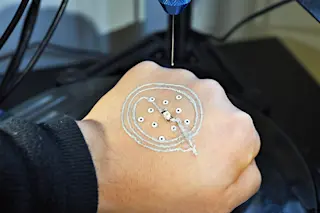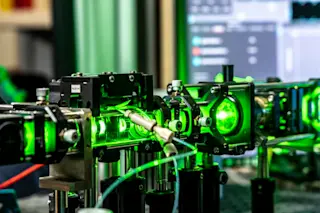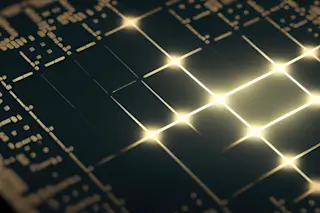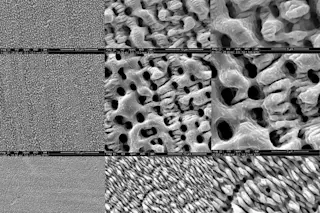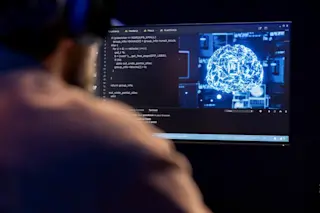An electronic circuit that's been 3-D printed onto a human hand. (Credit: Credit: McAlpine group, University of Minnesota) The concept of body hacking has been gaining popularity in recent years — the practice of integrating technology into our physical bodies to gain new abilities. It's interesting, but the procedures involved are usually pretty intense — think getting a camera put in the back of your head, or magnets in your fingers. A new concept from a researcher at the University of Minnesota offers a much simpler, though temporary, means of augmenting our bodies. Using a 3-D printer, Michael McAlpine simply draws an electrical circuit right onto the skin, to be used as a portable solar charger, chemical sensor and more.
The Electric Body
While on-body electronics aren't totally new — electronic "tattoos" include circuits that go right on the skin — the ability to print things right onto our bodies opens up a whole other range of possibilities. Printing custom circuits is one application, of course, and McAlpine suggests that soldiers could use his technique to print sensors onto their bodies to alert them of hazardous situations. But it could also be used to print biological cells right onto living tissue. In the paper, published Wednesday in Advanced Materials, McAlpine describes layering cells onto an open wound in a mouse, a technique that could in the future be used to help heal injuries and crate skin grafts. https://www.youtube.com/watch?time_continue=85&v=DTXqUrmr3FQ The system uses computer vision to adjust to tiny movements, a crucial ability when 3-D printing onto a living person. No matter how still we try to hold ourselves, it will never be perfect, and tiny jumps and jitters could throw off the printing process. McAlpine's system, however, can account for movements and position itself accordingly, allowing it to print complex designs onto unreliable surfaces. In addition, it relies on a solution of silver flakes that cure at room temperatures, rather than the skin-scorching temperatures other 3-D printing inks require. The silver flakes make up the "wires" of the circuit, and other tiny electronic devices can be added as needed depending on the circuit's function. When the user is done, the device can be simply peeled or washed off, which makes removal easy, but could impact the durability of the printed circuits. The researchers say that their technique is relatively low-cost, meaning that it could potentially be in reach for consumers one day. Need a heart rate monitor, or maybe an extra light on your hand? Perhaps we'll soon simply print them ourselves.


